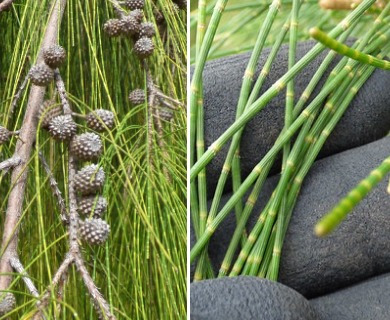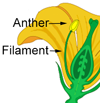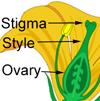Longleaf Ironwood
Casuarina glauca
Australian Pine family (Casuarinaceae)
Post-Cook introduction
This introduced species differs from related species in the longer and thicker drooping dull green wiry twigs 12–16 inches (30–40 ) long and nearly 1⁄16 inch (1.5 ) in diameter, with leaves 12–16 in a ring. The cone-like are about 1⁄2 inch (13 ) in diameter. Stands are easily recognized because they are dense or closely spaced due to the root suckering habit of the tree.

Forest And Kim Starr
Leaves consist of 12–16 tiny pointed brown 1⁄32 inch (1 ) long, about 1⁄2–3⁄4 inch (13–19 ) apart. Main twigs with rings as close as 1⁄8 inch (3 ), with longer leaves to 3⁄16 inch (5 ) and curved back, becoming stout, brown, and rough.
Flower clusters light brown, male and female apparently on different trees (). Male flower clusters (like spikes or ) at ends of long twigs, narrowly cylindrical, mostly 3⁄4–1 1⁄2 inches (2–4 ) long and 5⁄16 inch (8 ) in diameter. Male flowers crowded in rings of narrow pointed consist of one less than 1⁄8 inch (3 ) long with two tiny at base. Female flower clusters are short-stalked lateral balls (heads) about 1⁄4 inch (6 ) in diameter, consisting of with small and long threadlike
The multiple is a gray hard warty ball composed of many finely hairy points about 1⁄8 inch (3 ) long and broad, each from a flower. An individual splits open in two parts at maturity to release one winged light gray seed (nutlet) less than 1⁄4 inch (6 ) long.
Sapwood pale yellow and heartwood dark brown, often has a beautiful figure provided by the prominent oak-like The wood is hard, heavy, fine-textured, strong, but not durable in ground contact. It is difficult to season and to work. It takes a good polish, but is said to be brittle. Uses in Australia include shingles, fence rails, staves, paneling, furniture, oxen yokes, and marine piling. In Hawaii, it is used only for fuel.
By far, this is the most common species of Casuarina in the Forest Reserves, with almost 1 million trees planted. Because of its suckering habit, the species was early recognized as excellent for recapturing erosion scars. It has come into disfavor, however, because it also takes over good land wherever planted. Most ranchers in Hawaii regard it as A typical stand may be seen near the beginning of the Aiea Loop trail on Oahu.
Special area
Kalopa
Champion
Height 65 ft (20.9 ), c.b.h. 10.4 ft (3.2 ), spread 37 ft (11.3 ). Waikoekoe, Waimea Village, Hawaii (1968).
Range
Native of coasts of eastern and southern Australia.
Other common names
Longleaf casuarina, “salt-marsh ironwood” (Hawaii); swamp-oak, she-oak (Australia)
This species grows naturally in Australia along coasts in swampy margins of tidal areas and should be suitable for planting in saline soils.



